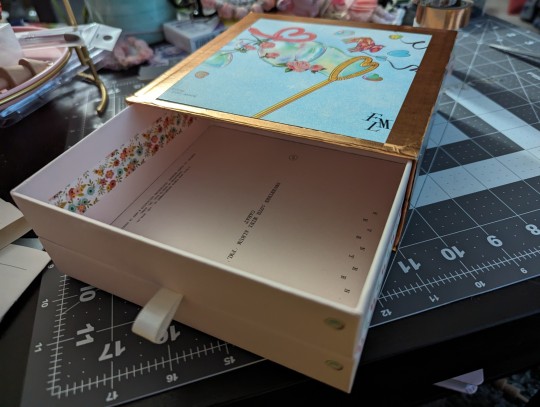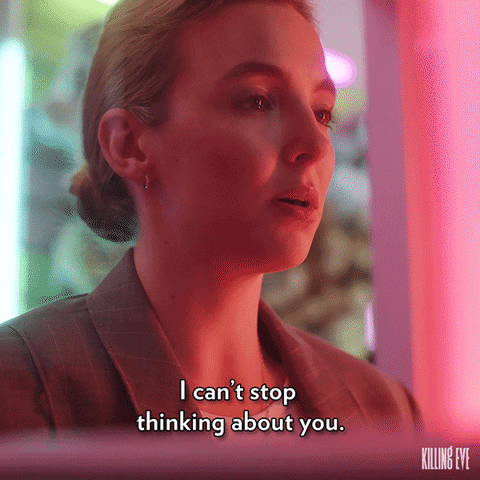#if i buy anymore i might make it a double decker since i love this carat ver so much all the boys look so good
Text



Please excuse the mess lol. I've seen a few people transform some of their FML carat ver into drawers. I finally did it to some of my extra copies!!
#if i buy anymore i might make it a double decker since i love this carat ver so much all the boys look so good#i wish i had more “seventeen” washi tape but i still think its cute
0 notes
Note
Hi! Recently I've been analyzing the scene where Eve puts the heart against her ear, listening to Villanelle's voice in s3 ep3, and would love to hear your take on it as well since I love to read your Tumblr posts. Do you think it was the first time Eve actually gave in to the feeling or just the first time the audience got to see it?

Suzanne Heathcote’s approach to Killing Eve was very much “tell-don’t-show,” so it was not a shock that the impression the viewers were left with was this was the first time Eve was actually owning up to how intense her feelings for Villanelle were.
Except it wasn’t. Not even close. We got that moment back in Season 2 with “Wide Awake” where over a few short minutes Eve is as honest and revealing with the psychologist Martin as she has been with anyone in the entire show.

Eve never tells Martin she’s in love with Villanelle. She hasn't even told Villanelle, but it hardly matters. She is in love with this woman, and she can’t stop thinking about her. It could not be more obvious.
This is a good thing, because under Heathcote’s tender mercies, Eve is just kinda doing stuff to be doing it. The rhyme or reason of it doesn’t matter anymore. It’s only important for her to go dumpster diving for cake boxes and running around Scotland stomping old ladies to death. Motivations be damned and pretty much all Eve's previous character development as well.
In Season 3, Eve never acknowledges out loud how deep under her skin Villanelle has gotten until they are on the bridge where she says she can’t envision a future without her in it. That’s good, but coming off of everything that came after the Rome fiasco, where is this coming from, Eve? Are you just so weary of the pointless snipe hunt that was the “Who Killed Kenny?” story arc or how your personality turned on a damn dime from obsessing over getting back with your husband to obsessing over getting back with your girlfriend?
It would be a revelation for someone to ask Sandra Oh, “At what point in Season 3 does Eve fall back in love/lust with Villanelle, and better yet, WHY does she?”

“Admit it, Eve. You wish I was here.” It’s a great scene. No lie. At first Eve’s flustered and then frustrated and a little pissed by that familiar voice coming out of that goofy toy. Then as she tears the heart out of it, she-can’t-stop-listening-to-it.
Eve's loneliness is matched by her longing for Villanelle. Obsession truly doesn't die even when the objects of obsession keep trying to murder one another.

What the talking bear doesn’t say is, “I can’t stop thinking about you.” Villanelle needs to maintain some distance between her true feelings for Eve and her pride and the admission that she misses Eve would be showing weakness. A swaggering Roman centurion-turned Emperor in a oversized grey suit facing off on a double-decker bus with an old foe who once hurt “him” greatly cannot be so vulnerable and soft (and what the fuck was up with that Roman centurion/smells like power bullshit, anyway?).
Villanelle was weird that whole episode. The opening kills with the Infinity Tuning Fork was weird. Baby-snatching the baby in order to play with it, right up until the kid starts crying or pooping, then the fun’s over, and she cackles with malicious glee when Dasha drops the little shitbird in the trash. Struts around London to select a new customized perfume, buy and customize a toy for Eve, break into Eve’s dump of an apartment, follow her to the bus, change clothes and bust a cap in The Twelve’s accountant while scaring the hell out of Carolyn and Mo, finally returning to a hotel for a shower and a little telly before calling it a night as she and Eve nurse their matching bruises.
That’s a pretty full and totally weird day for Villanelle. In the meantime, Eve gets a restless night tossing and turning all night as she keeps replaying V’s message until the battery dies or she climaxes. Whatever comes first.
Yeah, @dayyneee, I love the scene as much as you do as it comes in my favorite episode of my least favorite season. What bugs me most about it is it has really no effect on the following episodes.
Eve never mentions it again and Villanelle doesn’t even ask if she liked it. Uh--why is that, Killing Eve writers? Seemed like you went out of the way to make a point of the stuffed bear’s heart being a mighty big thing at the time, but after that it swirls down the memory hole never to be referenced again? What’s up with that?
Eve could have referred to the talking heart which would have given Villanelle a chance to ask how she liked her birthday cake and the postcard from Amsterdam intercepted by Carolyn in Season 2. Some might dismiss this as “fan service,” but I call it tying up loose threads that like so many other things on Killing Eve happen and are never heard from again.
If Laura Neal is doing a rewatch of the show, she’s filling up a pad with notes of things that need tidying up before the curtain comes down. What about “the heart?” is not the least of them.

39 notes
·
View notes
Text
Why We Love Interiors Invogue Prosecco Glasses (And You Should, Too!)
Transforming London: The New Breed Of Designers at the Super-Prime
London's modern-day HNWs have various priorities and needs for their houses-- and fresh brand-new designers are stepping up to satisfy the challenge with ingenious techniques, writes William Cash.

Every years-- or generation-- London sees a new type of interior designers or 'developer-designers' who stand apart and consult with an aesthetic voice, whose vision mixes easily with the architectural zeitgeist. While a lot of HNWs have actually heard of Candy & Candy (or at least their Monaco superyacht), Finchatton, or a custom company like Fenton Whelan, these 'designer brand' firms are all now regarded as well established. To put it simply, they've made lots of loan establishing in London's super-prime market, which up until recently was up 40 per cent given that 2009.
However, following punitive stamp task hikes, London's super-prime market is down 20 per cent. 'Billionaires are shunning the London luxury residential or commercial property market, with sales of "super prime" ₤ 10 million-plus homes in the capital collapsing by 86 per cent over the past year,' the Guardian reported in October. The paper cited figures from Land Registry which exposed that just five homes were sold for more than ₤ 10 million in the 3 months to August 2016, compared to 35 such residential or commercial properties in the exact same quarter the previous year. Outside London, no property offered for more than ₤ 10 million.
As always in the home development service, such cost falls have created new chances for designers who are tuned into the mindset of HNW customers, and more importantly are not trapped economically with a slate of expensive super-prime jobs and advancements on their books. HNW clients aiming to purchase 'off-plan' have different priorities-- such as wanting a two-bed lateral flat with sufficient entertaining area to host twenty for dinner, rather than a six-bedroom ₤ 11.5 million super-home.

The previous few years have the emergence of numerous under-the-radar people who are transforming the guidelines of interior design and of what it implies to develop a designer 'brand' today. Leaders consist of Katharine Pooley and Helen Green Design, which are following in the custom of the excellent London interior designer brands such as Colefax & Fowler.
What is most striking about such iconic 'designer' brand names is that, on the whole, clients concerned them since they wanted their hallmark look. Colefax & Fowler pioneered what is understood today as 'country house design', using a rejuvenating mix of contemporary elegant and traditional chintz that removed away the cluttered gloom of Victoriana. But the brand-new type of designers is moving away from the signature brand name look. Instead, their clients desire provenance, originality, artisan-craftsmanship, eccentric architectural details. These designer-developers have an approach of design that transcends the aesthetic into the practical.
Edo Mapelli Mozzi of Banda is enthusiastic about the phase set of modern urbane life. For each Banda task, 'designers, craftsmens and professionals are carefully chosen to ensure the houses we produce an interest the relevant market. We aim to exceed expectations in terms of the quality and service in the properties we deliver.'
Banda's acutely detailed bespoke work shows the most profound goals of HNW customers today and society's changing architectural tastes and domestic design. Edo, who was brought up and informed in England, has actually adopted the title of Noël Coward's 1932 play Design for Living for his branding functions. 'At Banda, our houses are built for life,'
he states.
With twelve years' experience, Edo and his team utilize their deeply ingrained 'market intelligence' (i.e. relationships with representatives and purchasers' agents) to source wacky properties, typically with some industrial heritage or architectural provenance. Using a group of 'artisan-craftsmen' and designers, the Banda idea is to just put its name to an advancement that has 'an original identity' and will 'make its own mark'.
The Banda Design Studio is uncommon because it offers a genuinely 'complete service' experience for HNWs, from interior design to architect's designs, through to the dressing of all show homes within advancements. The most talked-about designers of each generation are more than simple designers: they provide a window into the soul of our times and the Way We Live Now. Some 95 per cent of Banda's work is 'speculative advancement'; the other 5 percent is a private commission or job work.
Edo has actually been establishing 'character' properties in areas like Battersea, where he has had notable success converting an old pastry shop. 'A lot of our company model has been producing prime lateral flats outside the standard zone 1 location,' he says. He mentions that in locations like Nine Elms most two-bed flats vary from 900-1,300 sq ft. Think kitchen dinner for four-six if you squash around the table. 'So you can't amuse.'
His two-bed flats tend to be 2,000-3000sq ft. In one flat he had a 'bedroom that had his-and-hers dressing rooms, a big bathroom with an amusing area where you might have twenty for dinner or 40 for a drinks party. But it's a two-bedroom flat. And that doesn't exist on the market.' When Banda took these 'two-bed prime lateral' flats to market, all sold in 24 hours. 'We produced something that is not cookie-cut, is not what everyone else is producing.'
Edo says his client focus has actually constantly been based on listening to what 'owner-occupiers' desire, instead of the sales pitch of agents. 'We know there is a need from these sorts of downsizers, people in their early fifties whose kids have actually grown up, have left home. They require an extra bed room however they do not need a five-bedroomed home anymore. However they still desire the space they had.' A lot of also have an office area.
Another leading example of the leading brand-new type of designer is Andrew Murray, founder of Morpheus London design. I first met Andrew in May at the MIPIM exhibition in Cannes, where he had invited me to an unique lunch celebration. Andrew is likewise a co-partner (with Simon Davis) of the Rosebery, Britain's the majority of unique double-decker personal box bus-- more like a personal yacht embellished like a Mayfair club than your typical bus.
I asked him how a designer today can get the balance right between being a high-end 'brand name' (like the Rosebery) and at the very same time keep being unique and private as a business with private commission work. The answer is that Morpheus is rooted in artisan design work. His mother was an interior designer and his father 'very innovative', and this is the common DNA design aspect to all its jobs. Andrew started as a cabinet-maker and joiner, basically self-taught. 'This has been vital due to the fact that I understand how things are made, and I know how things must stream,' he says. 'So, coming from that craftsman background, the company developed as my exposure to luxury property evolved.'
Andrew's occupation started at Canford School in Dorset, which had an outstanding carpentry department. 'I set up my service when I was still at school,' he states. 'I embellished a workplace block when I was about sixteen and utilized people from school, which was quite enjoyable. So it evolved from there.'
Customers started asking him suggestions on all aspects of the style job-- not simply the cabinet he was making. 'I realised none had a complete service, and they were constantly at a little bit of a loss. So they were having this charming piece of cabinets made, however everything else didn't really match, and the provision of service wasn't there. It was really historic. It was extremely in the old school. And so I saw a chance to offer the sort of end-to-end service.'
Morpheus is now one of the most sought-out design firms in London, with clients all over Europe (for this reason the stylish but discreet lunch party at MIPIM). It wasn't constantly so attractive, though: his very first big task was the conversion of a large home in Stockwell in which the dance act KLF utilized to live. 'Then I ingratiated a designer in Mayfair who had a portfolio of 60 apartments-- rentals. I was about 25 then, and I took control of the advancement management of their maintenance, archive, repair-- so it led from there.'
The next move was to develop his own aesthetic design-- putting the Morpheus imprint on tasks without them becoming more about Morpheus than the client. 'I look quite at the function of area. Our designers do the interior design and the stylising, but I do the function, the flow, the function. Which was coming through really highly then, and I believe that's what caused success and caused growth.'
What makes Andrew the choice of moguls, UHNWs and City tycoons who desire their homes to stand out however also stay under the radar design brand-wise is his knowledge of who the very best craftspeople are. 'I can still go onto a website and state, "Actually, make it like that. It's much more industrial." So Morpheus is a design house, but we are also so much more than that-- we understand commercial truths. If a client states, "I've got four homes that I want you to design," I'm not even going to take a look at the style till I've understood the industrial organisation case. And I'm going to go, "Who's going to purchase it? Why are they buying? What do they desire?" And after that that will lead the style.'
0 notes
Text
Chris Churchill Saves the World | It Was Good While It Lasted: Saying Farewell to the Chicago Trolley & Double Decker Co
By Chris Churchill
Anyone who knows me knows a few things about me. Comedy, music, birds, and trolleys. Three passions and a job. Of course, I haven’t driven a trolley in about six months. I’m a teacher now. The music is still in me and so is the comedy. Only now I use those tendencies as I make my documentaries for the MFA program in Documentary Media at Northwestern University where I am now a student. Spoiler: not too many funny documentarians out there. The birds are all day every day with me. If it’s not the friends I share my apartment with, it’s the pigeons, the sparrows, the hawks, and the mourning doves that get my attention any time they seem to be busy with something outside. It’s the trolley thing that has gone away.
And I don’t mean just for me. Just found out last night that the company that employed me as a trolley driver/tour guide for twenty-one years is going out of business, after more than a quarter century on December 31st. I assume at the stroke of midnight, so as my wife called to my attention, it might affect a few New Year’s Eve celebrations. Definitely, a lot of spring and summer weddings that will need to adjust their transportation plans.
Two things strike me about this sudden news that I just received. As I look back, I realize that though we told stories about Chicago to millions upon millions of visitors over those years, we actually became part of Chicago’s history as well. The other thing that I realized was that Chicago Trolley & Double Decker Company was murdered from within and without; a slow death of slow poison and a thousand tiny cuts that ended with a young pirate running their sword through a dying old man.
The company was created by three guys from LaGrange back in the early nineties. Tim Lattner (son of the Heisman Trophy winner, Johnny Lattner), Rob Pierson, and Tim Carey. They built it from the ground up, just a few trolleys at first, and a few seasonal employees. They were up against Gray Line (a trolley tour company), American Sightseeing (a double decker company), and the Chicago Police, I’m sure, to find their niche in a crowded market and a spot on the sidewalk to sell tickets and pick up passengers. Believe it or not, this company existed for five years before they every hired me.
By the time I joined the company, it was established and on the verge of tearing down the competition. You don’t see too many Gray Line trolleys or American Sightseeing double deckers downtown anymore do you? While I’m sure there were other circumstances that helped it along, I’d like to say that, ultimately, we did that. We went out there and with superior tours, salespeople, hustle, and by outnumbering their vehicles, we became ubiquitous. We became the thing that was in a tourist’s mind when they thought, “I want to take one of those trolley tours in Chicago.”
And I can’t tell you how much I loved it and hated it over the years. How much I loved hustling for tips with sometimes corny, sometimes just bizarre trolley jokes. I can’t tell you how rewarding it was to eventually stop doing trolley jokes on my tour as I settled into my confidence as a tour guide. As I was just able to narrate the story of Chicago, as I saw it, to people who wanted to know. And the people I met and worked with over the last twenty-one years are among the most unique, talented, passionate, and fun loving people I’ve ever known.
As a performer, I’ve made good friends creating and performing comedy shows, rehearsing, writing, and producing stuff. When I was an active comedian, I made some good comedian friends. I make friends wherever I go. But these trolley people… these are the people I think of all the time. There are people I worked with who passed on long ago but who I think of all the time. There are people who were there before I got there and appear to be riding this last trolley into its last loop around downtown. And these people are my family outside of my family and my mobile home away from home.
I’d tell you more, but that would take a book. So I wrote a book and Literate Ape put it out.
Buy it. Read it. Tell others.
“Twenty Years Without A Weekend”
So that pirate I talked about in the earlier metaphor—I saw them coming, and luckily for me, I was already on my way to another life when they showed up. The trolley company was purchased by, I guess you’d call them, a venture capitalist or maybe a turnaround artist. They don’t necessarily call themselves that. But when you look at the website for the company that just bought your parent company, you know. A bunch of young millionaire bios all over the About Us page. They were just doing a vague, big money, thing with no real mission other than making bigger money. Then, you add that the rest of their portfolio had absolutely nothing to do with transportation or tourism, the smell in the stockyards, where the trolleys are parked, became stronger than usual.
But this wasn’t the only corporate greed that killed us. Let’s not forget all the tiny cuts that left us vulnerable. When the company started, it was special, the owners had vision, the employees were on a mission. Then it got purchased by a transportation company and it slowly began to lose some of its focus. Little by little, the tour company became more of a transportation company. The trolleys were secondary to the larger corporation’s larger goal. That was what started it.
Then our success became a problem. Once we became the biggest game in town, we had to hire a lot of people, and quality control started to falter. It was no longer a small, focused crew. It was whomever could respond to our desperate cries for help in the Reader or hiring fairs we’d set up next to Second City.
Then, Megabus happened too. That discount bus company is owned by the same people who own Chicago Trolley & Double Decker. They share the lot with all the trolleys and double deckers. They also shared the attention and resources of the transportation company that, knowing or caring little about tours, was only skilled in the logistics of transportation but not of running a tour company.
So by a few years ago, the number of complaints about our tour grew. Check out our Yelp page. And we were too spread out as a company to do anything to affect a turnaround in the overall quality of our product. This isn’t to say that there weren’t a lot of great tour guides. There were always about ten really great ones, myself included. But when the ten great ones are outweighed, in the summer, by fifty poorly trained ones, well… you get the picture. I finally started telling tourists who rode with us in winter that they were getting the best tour because we only kept the good tour guides employed through the winter slow season.
That penultimate slash to our skins, cutting across the wrist but not yet the jugular, was a new kid in town named Big Bus. They came from out of town. They were built out of money. Built from the top down, rather than from the ground up. They came to town with one of their main goals to put Chicago Trolley & Double Decker Company out of business.
Doesn’t that sound familiar? That’s essentially what we accomplished with out rivals back in the day. What comes around goes around I guess. Big Bus will have its day in the sun and then the sun will set for them, too. This is not bitterness, just an observation of truth. Turn, turn, turn.
So I take a moment to think about how synonymous with Chicago tourism and just how special our company became during those years. We were part of the history of this town.
For many years, we were the Navy Pier Trolley. We were the city’s free trolley system that ran for a decade. We were the double deckers that carried the Chicago Blackhawks through Chicago after three separate Stanley Cup wins. And We were the company that carried the Cubs through the streets of Chicago and delivered them to the thirtieth largest gathering of humans in one place in the history of the world. Most of the gatherings ahead of that were religious pilgrimages. We were the trolleys on an evacuated Lake Shore Drive taking guests to and from the election night rally for Barack Obama in November 2008. That was us. That was history. We were a part of history.
I’m biased, of course. I’m also romanticizing a bit (it has been six months since I wore the khaki’s and red polo). But seriously, we were a great tour company for a long time—until we weren’t. We were a huge part of what made visiting Chicago special for over twenty-five years. And now it is officially history.
#chicago history#trolley#big business#end of an era#Chicago Trolley & Double Decker Company#Johnny Lattner
0 notes
Text
British Airways Plan to Add ‘Pre-Reclining’ Seats Actually Makes Sense — Airline Innovation Report
British Airways hasn't announced many changes to the A319 interior, pictured here. But it is making some big alternations to its A320 and A321 fleet. Stuart Bailey / British Airways
Skift Take: We all wish British Airways hadn't decided to shrink seat pitch. But once it did so, it was smart to go with so-called pre-reclined seats. When there's so little space between seats, passengers don't need another passenger reclining into them.
— Brian Sumers
The Skift Airline Innovation Report is our weekly newsletter focused on the business of airline innovation. We will look closely at the technological, financial, and design trends at airlines and airports that are driving the next-generation aviation industry.
We also provide insights on developments in passenger experience, ancillary services, revenue management, loyalty, technology, marketing, airport innovation, the competitive landscape, startups, and changing passenger behavior. I write and curate the newsletter, and we send it on Wednesdays. You can find previous issues of the newsletter here.
On a continent where flyers expect many short-haul one-way flights to cost 20 or 30 euros ($24 to $36), if bought in advance, British Airways has a choice. It can ignore budget-conscious passengers and let them continue to defect to Ryanair or EasyJet, or it can lower its costs to compete.
After more than a decade of ignoring them — perhaps hoping they’d go away — British Airways is fighting. That’s bad news for customers, who hate that their beloved brand has removed free food from short-haul flights, and moved to shrink legroom and width on many planes. But it’s probably the only option. Legacy airlines like British Airways still make a significant portion of their revenue from corporate customers, but they can’t ignore everyone else.
This week, another story went viral about the airline’s cost-cutting plans. As it adds seats to some planes — a process known as densification — some aircraft will get seats that do not recline. Or, as an airline spokeswoman put it in an email, the seats “will be pre-reclined at a comfortable angle.”
That British Airways will add seats is not news. The airline long ago told investors it would densify its short-haul fleet, with planes having seat pitch of 29 inches — the same as EasyJet and two inches fewer than Delta Air Lines. The premise is simple: If British Airways adds more seats to each plane, it can charge less money for each ticket, and still profit from each flight.
Predictably, British tabloids have criticized the UK’s flag carrier. But this week, I spoke to a couple of insiders with experience at ultra-discount airlines that use seats that don’t recline. And they told me this is probably good news for the airline and its customers.
Here’s why:
It’s feasible for an airline to offer 29-inch pitch seats that recline. Rouge, Air Canada’s low-cost brand, has 29-inch pitch on its A321s, according to SeatGuru. But that often isn’t so pleasant for customers. In a space that tight, the discount airline insiders said, travelers don’t want to worry about the passenger ahead of them reclining into their lap. Seats that don’t recline, one insider said, are probably “more palatable” to customers than a typical 29-inch pitch seat. As BA’s spokeswoman put it, “This also has the benefit of helping to preserve space for the customer in the seat behind.”
Airlines hate moving parts, and though it seems like seat recline would work via a simple mechanism, it’s not so straightforward. A kid might repeatedly whack the recline button, or an adult might try to force the recline further than it goes. “Those things break a ton,” one insider said. The maintenance can be deferred, so flights wouldn’t be canceled, but broken recline must be fixed at some point.
The insiders say they’ve crunched the numbers and found airlines might gain a small fuel burn savings from seats that don’t recline. Simple seats are generally lighter because they have fewer parts, and a lighter plane is cheaper to operate. Over time, the fuel savings can add up, but the insiders still say maintenance savings are far greater than fuel savings.
The insiders say passengers don’t complain much about the so-called pre-reclined seats. In the beginning, it may come as a surprise to passengers, and some might be upset. But over time, they get used to it.
Do you know more about why an airline would use seats that don’t recline? Let me know via email [[email protected]] or through Twitter. I’m @briansumers.
— Brian Sumers, Airline Business Reporter
Stories of the Week
The Airport of the Future May Evolve From Transport Hub to Attraction: One architect told me he dreams of putting parks, complete with wildlife and plants, into airports. Another said future airports probably won’t need parking garages because we’ll all arrive in driverless cars. A third predicted giant airport check-in lobbies eventually will disappear because travelers won’t need much more than a place to drop bags anymore.
Airlines Turn to Private Messaging to Avoid Social Media Blowups: A few years ago, airline social media teams lived in fear that a celebrity or other influencer would send a viral tweet about the airline. That’s still a concern, but according to Joshua March, co-founder and CEO of Conversocial, many more customers are trying to get issues resolved via private messaging. “If you look at what customers want, they want a quick and easy response,” he told me. “Tweeting publicly was a way to get attention. But people don’t want to complain publicly if they are going to get a response relatively quickly.”
EasyJet Is Transforming the German Market With Launch of Domestic Routes: EasyJet bought some of Air Berlin’s assets in Berlin, allowing it to grow in the German market. It’s hoping to pick up some corporate customers with frequent flights to business destinations, but can it compete with Lufthansa?
JFK Airport’s Terminal Setup Contributed to the Storm-Recovery Fiasco: Most of the world’s airports have lots of “common-use gates” that can be used by any carrier. Not JFK. It operates under a different model, and that has been a big problem over the past week.
Bag Fees Were the Most Successful Airline Business Model Change of the Past Decade: Welcome to Micheline Maynard, an accomplished journalist and author, and former Detroit bureau chief for The New York Times. She’s Skift’s newest aviation contributor. In her first piece, she explores the bag fee phenomenon at U.S. airlines. Amazingly, it has been almost a decade since American Airlines began charging for a first checked bag.
U.S. Travelers Soon Will Need Enhanced IDs to Board Planes — For Real This Time: For more than a decade, we’ve heard some U.S. state IDs might not be sufficient for boarding an airplane. But whenever a deadline has been announced for states to comply, the federal government ends up postponing it. Now, the Trump Administration says it means what it says — soon U.S. travelers will need enhanced IDs to fly. Bloomberg’s Justin Bachman has the story.
United Airlines Fills Out Route Map With 8 New Routes: In late 2016, United President Scott Kirby promised his airline would grow in smaller U.S. cities, where fares are generally higher than in larger cities. This week, United announced a slew of new routes, and there are some unusual ones, including San Francisco to Madison, Wisconsin — a long route on an Embraer E175 regional jet — Denver to Appleton, Wisconsin, and Los Angeles to Eureka, California. If you follow this closely, you know Kirby believed United grew too much on international routes under its previous leadership, and erred by not starting more domestic flights. Ben Mutzabaugh of USA Today has the story.
As Alaska Air Cuts Costs, Employee Discontent Grows and Passenger Loyalty Is at Risk: The Seattle Times reports that many of Alaska Air’s unionized employees are upset with management for being too obsessed with cost cuts. I would have preferred less emphasis on front-line employees for this story, and more about morale at headquarters. But it’s still an interesting read. The takeaway: Mergers are hard.
Rival Airlines Emirates, Etihad Step Closer With Security Pact: The two Gulf airlines will share information and intelligence, according to Reuters. Is this a first step toward a merger?
Boeing 747 Retirement: Farewell to the ‘Queen of the Skies’: CNN’s Jon Ostrower rode on the last U.S. airline Boeing 747 flight. For real this time. There have been lots of “lasts” for United and Delta, the final two U.S. operators of the double-decker plane. But this really was the final one — a ride from Atlanta to Marana, Arizona, “an arid boneyard for stored and cannibalized jetliners.”
Coming Up
I’ll profile two airlines with unusual business models — JetSuiteX on the West Coast, and OneJet, in the East and Midwest.
The airlines don’t love being compared with each other because they have slightly different strategies. JetSuiteX uses private terminals, and it’s willing to launch a route, like Burbank to Oakland, even if Southwest flies it. OneJet uses traditional terminals, and tries to fly routes where there is no competition, such as Pittsburgh to Hartford.
But the basic premise is the same. I spoke to both CEOs this week, and they said they see a niche because major carriers have pulled too much capacity from small- and medium-sized airports. JetSuiteX sees opportunity in places like Santa Barbara and Carlsbad, California, while OneJet sees it in Pittsburgh, Milwaukee, and Kansas City.
Both airlines seem to think the Embraer E135 is the right jet for long-term growth. Regional airlines and mainline partners hated the E135 a decade ago, saying the 37-seat jet had poor economics for a typical hub-and-spoke network. But they’re cheap to buy now, and OneJet and JetSuiteX want them. Each is putting 30 seats on the aircraft.
“You are just seeing such extraordinary values in terms of the acquisition prices,” said Matthew Maguire, CEO of OneJet.
What do you think of these two airlines? Do you think they can make it?
Meet Me in San Francisco
Reminder: Skift will hold a free event on January 30 in San Francisco to share our Megatrends — an overview of what we expect for travel in 2018. There will also be refreshments!
It’s at the The Pearl, located at 601 19th Street in San Francisco, and goes from 6 p.m. to 8:30 p.m. I’ll be there, and hope you can join.
Tickets are available here.
Subscribe
Skift Airline Business Reporter Brian Sumers [[email protected]] curates the Skift Airline Innovation Report. Skift emails the newsletter every Wednesday. Have a story idea? Or a juicy news tip? Want to share a memo? Send me an email or tweet me.
Subscribe to the Skift Airline Innovation Report
0 notes